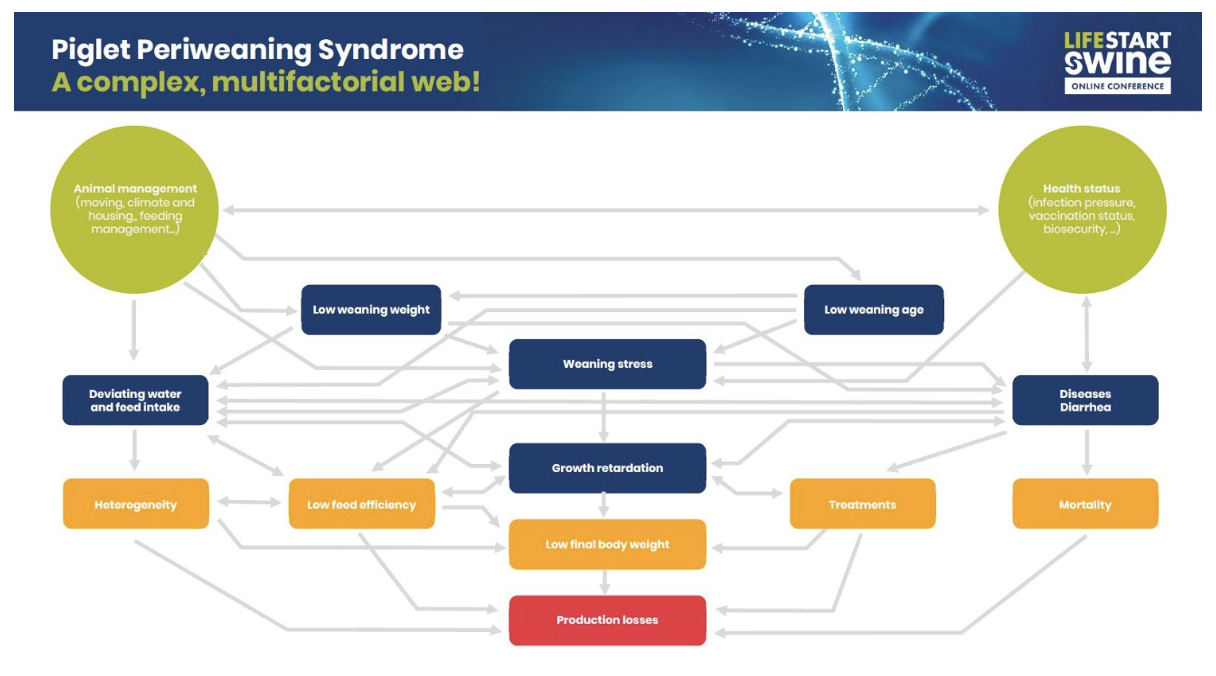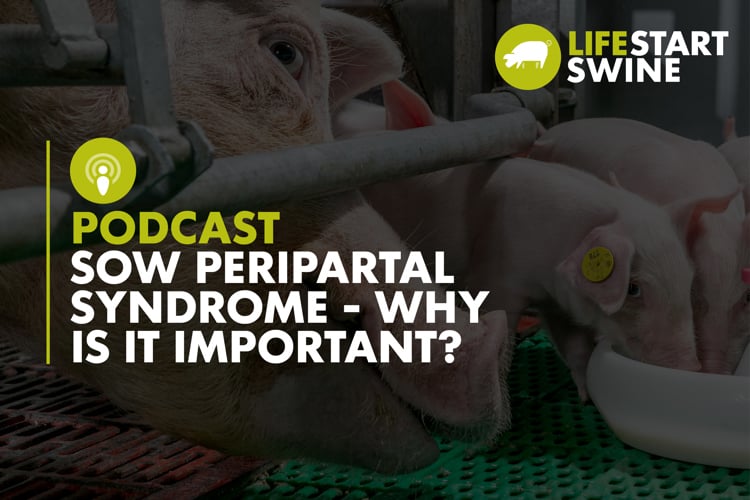- 2022
- GESTATION
Sarah Mikesell, from LifeStart Swine, interviews Dr. Ruben Decaluwe, the Global Technical Manager of Swine Young Animal Feed at Trouw Nutrition. Dr. Decaluwe is based in Belgium. Prior to working with Trouw Nutrition, his PhD research was focused on colostrum production.
Describe the sow peripartal syndrome and why it’s important?
The sow peripartal syndrome is a roadmap to describe all the challenges that become visible around farrowing, both at the sow and at the piglet level. Our key message is that everything is connected. When we put it in a picture, it's a very complex schematic at first sight. But that's also the key message – that if you have a problem happening around farrowing, it’s likely caused by multiple factors rather than one challenge with an easy solution. To tackle the real issues, we need to understand the underlying factors.

The challenges at the sow and the piglet levels all clearly have one thing in common - they lead to potential production losses. When it comes to sow challenges, they are not always visible, but we do know that they always lead to piglet challenges. For example, with hypogalactia, or insufficient colostrum or milk production, the sow won’t necessarily suffer, but it has a significant impact on the piglets. They will likely have low vitality, high mortality and growth retardation which all cause production losses. Thus, hypogalactia can be a huge problem, especially with hyperprolific sows. Multiple factors can cause hypogalactia, so before starting to tackle it, you first need to do a deep dive and understand all the interacting factors and underlying risk factors that are causing the problem.
What are some practical solutions to reduce the impact of the factors?
As mentioned earlier, everything is connected. The production losses identified on a farm can be caused by a wide range of factors. A challenge you see today could have been caused by a problem that happened weeks or months earlier. Working through the interconnected challenges requires a team of specialists to come together including yourself, your veterinarian and your nutritionists.
To recap and continue with the hypogalactia example, the production losses described are mostly at the piglet level, but consider both the sow and the piglet. Your deep dive to determine the root issue should be focused in three core specialties on the pig farm - animal management, health management and farm management.
Animal management. From the moment you move sows from the gestation area to the farrowing unit, it can have an impact on the milk production in sows. It may not go wrong, but it's a stress to the animal and therefor a risk factor. If there hasn’t been a problem with hypogalactia previously, it might mean that you're moving sows at the wrong moment, or your climate is off, or the heat lamps are hanging in the wrong place and overheating the mammary gland. Genetics can also be very important, because different sow breeds have different milk production yield capabilities.
Health management. It’s not difficult to understand that a sow will have a drop in milk production when she’s sick. Think about an influenza outbreak in the farrowing room. If the pigs are already born, then milk production is the next concern because sows with a high fever will not produce a lot of milk. Or another example is a sow with claw lesions will have a drop in milk production because sows will not stand up that easily and they will reduce their feed and water intake which are required for the sow’s body to produce milk.
Feed and water management. Poorly formulated diets and insufficient access to fresh water can both lead to constipation in sows, and there’s a clear correlation between constipation and lower milk production. For example, if sows need to drink from the nipple all the time, consider giving them a few days of free access to water around farrowing. Poorly formulated diets or diets that are too low in fiber can also lead to constipation. Body condition is also important to monitor. Overweight and underweight sows will produce less milk. How do you create fat and skinny sows? It's done with feed management programs. A deviating body condition does not happen at farrowing or at the moment you are facing milk production problems, it happens throughout gestation or even during the previous production cycle.
What a farmer or practitioner can learn from the sow peripartal syndrome is to keep an open mind to all the problems that can occur and try not to fall back on the old habit of treating the symptoms and not the root problem. One problem or challenge can be caused by a variety of underlying factors and risk factors, so understand that everything is connected. It's not always about feed or pathogens; it’s more likely about feed and pathogen management. Also try to work together as a coordinated team on the feed management, farm management and health management. All these specialties are important to have successful pig production.



